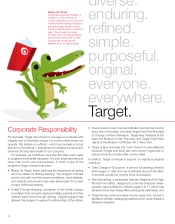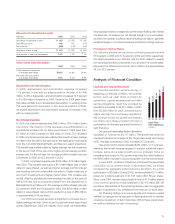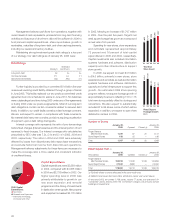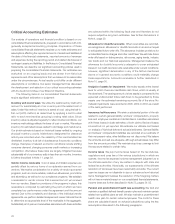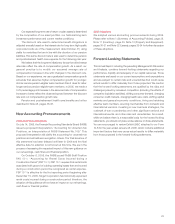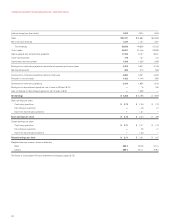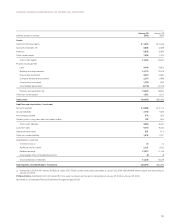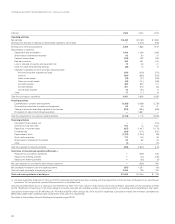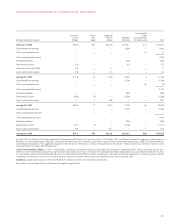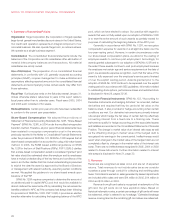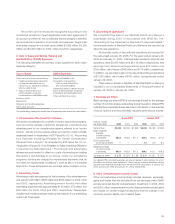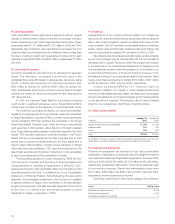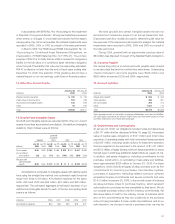Target 2005 Annual Report Download - page 23
Download and view the complete annual report
Please find page 23 of the 2005 Target annual report below. You can navigate through the pages in the report by either clicking on the pages listed below, or by using the keyword search tool below to find specific information within the annual report.
21
Commitments and Contingencies
At January 28, 2006, our debt, lease, real estate and purchase
contractual obligations were as follows:
Contractual Obligations
Payments Due by Period
Less than 1–3 3– 5 After 5
(millions) Total 1 Year Years Years Years
Long-term debt (a) $9,792 $751 $2,772 $2,987 $3,282
Interest payments –
long-term debt (b) 4,274 557 929 692 2,096
Capital lease
obligations 223 12 25 26 160
Operating leases (c) 3,097 137 255 221 2,484
Real estate obligations 838 818 20 — —
Purchase obligations 1,431 431 434 222 344
Standby letters of credit (d) 104 102 2 — —
Contractual cash
obligations $19,759 $2,808 $4,437 $4,148 $8,366
(a) Required principal payments only. Excludes SFAS No.133, “Accounting for
Derivative Instruments and Hedging Activities,” fair market value adjustments
recorded in long-term debt.
(b) Includes payments on $1,650 million of floating rate long-term debt secured by
credit card receivables, $750 million of which matures in 2007 and $900 million
of which matures in 2010. These payments are calculated assuming rates of
approximately 5 percent for each year outstanding. Excludes payments received
or made related to interest rate swaps discussed on page 33.
(c) Total contractual lease payments include certain options to extend the lease term,
in the amount of $1,421 million, that are expected to be exercised because the
investment in leasehold improvements is significant and also includes $122 million
of legally binding minimum lease payments for stores opening in 2006. Refer to
Note 22, pages 33-34, for further discussion of leases, including a definition of
what is included in and excluded from rent expense.
(d) Primarily related to the portion of our insurance claims for which we have retained
the risk.
Real estate obligations include commitments for the purchase,
construction or remodeling of real estate and facilities. Purchase
obligations include all legally binding contracts such as firm minimum
commitments for inventory purchases, merchandise royalties,
purchases of equipment, marketing-related contracts, software
acquisition/license commitments and service contracts.
In the normal course of business we issue purchase orders to
purchase inventory, which represent authorizations to purchase and
are cancelable by their terms. We do not consider purchase orders
to be firm inventory commitments and therefore they are excluded
from the table above. We also issue letters of credit in the ordinary
course of business which are excluded from this table as these
obligations are conditional on the purchase order not being cancelled.
If under certain circumstances, and at our sole discretion, we choose
to cancel a purchase order, we may be obligated to reimburse the
vendor for unrecoverable outlays incurred prior to cancellation.
We have not included obligations under our pension and post-
retirement health care benefit plans in the contractual obligations table
above. Our historical practice regarding these plans has been to
contribute amounts necessary to satisfy minimum pension funding
requirements plus periodic discretionary amounts determined to be
appropriate. Further information on these plans, including our expected
contributions for 2006, is addressed in Note 28 on pages 36-38.
Market Risk
Our exposure to market risk results primarily from interest rate changes
on our debt obligations and on our credit card receivables, the majority
of which are now assessed finance charges at a prime-based floating
rate. At the end of 2005, our level of floating-rate debt obligations
approximated our level of floating-rate credit card assets. As a result,
based on our balance sheet position at January 28, 2006, interest
rate changes would have approximately offsetting impacts on our net
interest expense and finance charge revenues. To preserve our net
interest margin, we intend to maintain sufficient levels of floating-rate
debt to generate parallel changes in net interest expense as finance
charge revenues fluctuate. See further discussion in Note 21, page 33.
In addition, we are exposed to fluctuations of market returns on
our qualified defined benefit pension and non-qualified defined
contribution plans. The annualized effect of a one percentage point
decrease in the return on pension plan assets would decrease plan
assets by $19 million at January 28, 2006. The resulting impact on
net pension expense would be calculated consistent with the
provisions of SFAS No. 87, “Employers’ Accounting for Pensions.”
See further discussion in Note 28, pages 36-38. The annualized effect
of a one percentage point change in market returns on our non-
qualified defined contribution plans (inclusive of the effect of the
investment vehicles used to manage our economic exposure) would
not be significant. See further discussion in Note 27, page 36.
We do not have significant direct exposure to foreign currency
rates as all of our stores are located in the United States and the vast
majority of imported merchandise is purchased in U.S. dollars.
Overall, there have been no material changes in our primary risk
exposures or management of market risks since the prior year.
Analysis of Discontinued Operations
Marshall Field’s and Mervyn’s were divested in 2004; no financial results
of discontinued operations are included for the year ended January 28,
2006. In 2004, revenues and earnings from discontinued operations
reflected only a partial year of results and excluded the holiday season.
For the years ended January 29, 2005 and January 31, 2004, total
revenues included in discontinued operations were $3,095 million
and $6,138 million, respectively, and earnings from discontinued
operations were $75 million and $190 million, net of taxes of $46 million
and $116 million, respectively. In addition, we recorded a gain on the
sale of discontinued operations of $1,238 million, net of taxes of
$761 million, during the year ended January 29, 2005.





